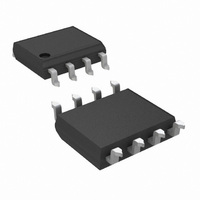LM4889MA/NOPB National Semiconductor, LM4889MA/NOPB Datasheet - Page 10

LM4889MA/NOPB
Manufacturer Part Number
LM4889MA/NOPB
Description
IC AMP AUDIO PWR 1W MONO 8SOIC
Manufacturer
National Semiconductor
Series
Boomer®r
Type
Class ABr
Datasheet
1.LM4889MMNOPB.pdf
(20 pages)
Specifications of LM4889MA/NOPB
Output Type
1-Channel (Mono)
Max Output Power X Channels @ Load
1W x 1 @ 8 Ohm
Voltage - Supply
2.2 V ~ 5.5 V
Features
Depop, Shutdown, Thermal Protection
Mounting Type
Surface Mount
Package / Case
8-SOIC (3.9mm Width)
Amplifier Class
AB
No. Of Channels
1
Output Power
1W
Supply Voltage Range
2.2V To 5.5V
Load Impedance
8ohm
Operating Temperature Range
-40°C To +85°C
Amplifier Case Style
SOIC
Rohs Compliant
Yes
Lead Free Status / RoHS Status
Lead free / RoHS Compliant
Other names
*LM4889MA
*LM4889MA/NOPB
LM4889MA
LM4889MANOPB
LM4889MANOPB
*LM4889MA/NOPB
LM4889MA
LM4889MANOPB
LM4889MANOPB
Available stocks
Company
Part Number
Manufacturer
Quantity
Price
Company:
Part Number:
LM4889MA/NOPB
Manufacturer:
National Semiconductor
Quantity:
1 977
www.national.com
needed to couple in low frequencies without severe attenua-
tion. But in many cases the speakers used in portable sys-
tems, whether internal or external, have little ability to
reproduce signals below 100 Hz to 150 Hz. Thus, using a
large input capacitor may not increase actual system perfor-
mance.
In addition to system cost and size, click and pop performance
is effected by the size of the input coupling capacitor, C
larger input coupling capacitor requires more charge to reach
its quiescent DC voltage (nominally 1/2 V
comes from the output via the feedback and is apt to create
pops upon device enable. Thus, by minimizing the capacitor
size based on necessary low frequency response, turn-on
pops can be minimized.
Besides minimizing the input capacitor size, careful consid-
eration should be paid to the bypass capacitor value. Bypass
capacitor, C
on pops since it determines how fast the LM4889 turns on.
The slower the LM4889's outputs ramp to their quiescent DC
voltage (nominally 1/2 V
Choosing C
the range of 0.1 µF to 0.39 µF), should produce a virtually
clickless and popless shutdown function. While the device will
function properly, (no oscillations or motorboating), with C
equal to 0.1 µF, the device will be much more susceptible to
turn-on clicks and pops. Thus, a value of C
is recommended in all but the most cost sensitive designs.
AUDIO POWER AMPLIFIER DESIGN
A 1W/8Ω Audio Amplifier
A designer must first determine the minimum supply rail to
obtain the specified output power. By extrapolating from the
Output Power vs Supply Voltage graphs in the Typical Per-
formance Characteristics section, the supply rail can be
easily found. A second way to determine the minimum supply
rail is to calculate the required V
add the output voltage. Using this method, the minimum sup-
ply voltage would be (V
V
vs Supply Voltage curve in the Typical Performance Char-
acteristics section.
Given:
OD
Power Output
Load Impedance
Input Level
Input Impedance
Bandwidth
BOT
and V
B
B
OD
, is the most critical component to minimize turn-
equal to 1.0 µF along with a small value of C
TOP
are extrapolated from the Dropout Voltage
DD
opeak
), the smaller the turn-on pop.
+ (V
100 Hz–20 kHz ± 0.25 dB
opeak
OD
TOP
using Equation 2 and
+ V
B
DD
equal to 1.0 µF
). This charge
OD
BOT
)), where
1 Wrms
1 Vrms
20 kΩ
8Ω
i
i.
(in
A
B
10
5V is a standard voltage in most applications, it is chosen for
the supply rail. Extra supply voltage creates headroom that
allows the LM4889 to reproduce peaks in excess of 1W with-
out producing audible distortion. At this time, the designer
must make sure that the power supply choice along with the
output impedance does not violate the conditions explained
in the Power Dissipation section.
Once the power dissipation equations have been addressed,
the required differential gain can be determined from Equa-
tion 3.
From Equation 3, the minimum A
Since the desired input impedance was 20 kΩ, and with a
A
allocation of R
is to address the bandwidth requirements which must be stat-
ed as a pair of −3 dB frequency points. Five times away from
a −3 dB point is 0.17 dB down from passband response which
is better than the required ±0.25 dB specified.
As stated in the External Components section, R
junction with C
The high frequency pole is determined by the product of the
desired frequency pole, f
a A
which is much smaller than the LM4889 GBWP of 2.5MHz.
This calculation shows that if a designer has a need to design
an amplifier with a higher differential gain, the LM4889 can
still be used without running into bandwidth limitations.
VD
VD
impedance of 2, a ratio of 1.5:1 of R
f
f
C
L
H
i
= 3 and f
= 100 Hz/5 = 20 Hz
= 20 kHz * 5 = 100 kHz
≥
1/(2π*20 kΩ*20 Hz) = 0.397 µF; use 0.39 µF
i
i
= 20 kΩ and R
create a highpass filter.
H
= 100 kHz, the resulting GBWP = 300kHz
R
H
f
, and the differential gain, A
/R
i
(2)
(3)
= A
f
= 30 kΩ. The final design step
VD
VD
/2
is 2.83; use A
f
to R
i
results in an
VD
i
VD
= 3.
in con-
. With











